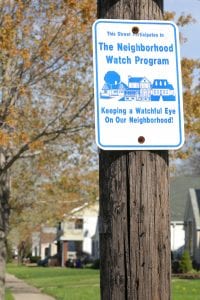This is part six of a series of articles about Neighborhood Watch programs.
 Community problems–ranging from vandalism to drug abuse and violent crime–have no easy answers. Law enforcement alone cannot eliminate these problems. Citizens working in partnership with law enforcement, however, discover effective ways to resolve even the most critical community concerns. The following is a simple but effective problem-solving process to identify and address concerns affecting your neighborhood and community.
Community problems–ranging from vandalism to drug abuse and violent crime–have no easy answers. Law enforcement alone cannot eliminate these problems. Citizens working in partnership with law enforcement, however, discover effective ways to resolve even the most critical community concerns. The following is a simple but effective problem-solving process to identify and address concerns affecting your neighborhood and community.IDENTIFY CONCERNS
Team with other residents to make a list of concerns and issues affecting the area, then prioritize which issues need to be acted on first.
RECOGNIZE UNDERLYING CAUSES
As a group ask, “What was the underlying cause of this problem?” By recognizing the cause of the problem, it will be easier to develop a strategy for preventing it from occurring again.
IDENTIFY PARTNERS
With the help of law enforcement, identify key individuals and organizations that may be potential partners in the problem-solving process.
CREATE STRATEGIES
Once you have gathered the information you need to problem solve, begin to form a strategy. Be sure to use community partners you identified earlier in tailoring a strategy to best fit the problem.
IDENTIFY OBSTACLES
Identify rather than ignore specific obstacles you encounter as you work toward a solution. An ignored obstacle becomes an entirely new problem to address.
RECOGNIZE RESOURCES
Determine what resources your strategy may need, then contact local businesses or individuals who would be willing to help fund a community effort.
PRIORITIZE ISSUES
Decide what issue is most urgent and begin with that issue first.
ACT
Try to follow the strategy’s original plan for solving the issue and make changes and adjustments only as unforeseen situations arise.
EVALUATE ACTIONS
Evaluate the result of your actions by reviewing what happened and whether the action was effective in resolving the problem. Determine which aspects of the action were successful and consider using those on future issues your group encounters.
_
Neighborhood Watch Article Series
- Part One: “What is a Neighborhood Watch?”
- Part Two: “A Neighborhood Watch is Not…”
- Part Three: “Organizing a Neighborhood Watch”
- Part Four: “The Neighborhood Watch Meeting”
- Part Five: “The Role of Neighborhood Watch Members”
- Part Six: “Neighborhood Watch: Solving Problems”
- Part Seven: “What Motivates Neighborhood Watch Members”
- Part Eight: “How Neighborhood Watches Grow”
_
The Cleveland Police Foundation, in partnership with the Cleveland Division of Police and the Ohio Crime Prevention Association present these tips so citizens can help to make our community safer.